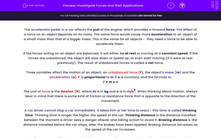The accelerator pedal in a car affects the pull of the engine, which provides a forward force. The effect of a force on an object depends on its mass. The same force would cause more acceleration to an object of a small mass than that of a bigger mass. This is the same for all objects - they need a force to be able to accelerate them.
If the forces acting on an object are balanced, it will either be at rest or moving at a constant speed. If the forces are unbalanced, the object will slow down or speed up, or even start moving (if it were at rest previously). The result of unbalanced forces is called a net force.
Three variables affect the motion of an object: an unbalanced force (F), the object's mass (m) and the acceleration (a). F is proportional to m if a is constant, and the formula is:
F = m x a
The unit of force is the Newton (N), where m is in kg and a is in m/s2. When thinking about motion, always bear in mind that there is some kind of friction or resistance force that is opposite to the direction of the movement.
A car driver cannot stop a car immediately. It takes him or her time to react - this time is called thinking time. Thinking time is longer the higher the speed of the car. Thinking distance is the distance travelled between the moment a driver sees a danger ahead, and taking action to avoid it. Braking distance is the distance travelled before the car stops, after the brakes have been applied. Braking distance increases as the speed of the car increases.
Lots of important stuff to get your head around here. Let's get on to the questions and see how much you can remember!








